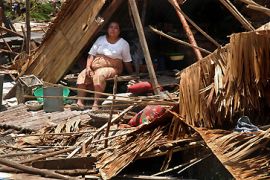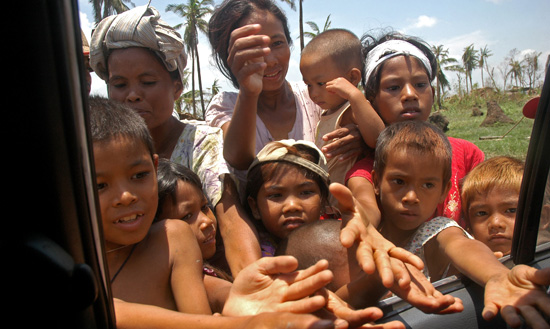Disease stalks cyclone survivors
A week after Myanmar’s deadly cyclone, survivors face grim fight for survival.

 |
| With little access to food or clean water survivors now face a growing threat of disease [AFP] |
Keep reading
list of 4 itemsTurtles swimming to extinction in Malaysia as male hatchlings feel heat
Could shipping containers be the answer to Ghana’s housing crisis?
Thousands protest against over-tourism in Spain’s Canary Islands
Almost a week after Cyclone Nargis hit Myanmar, survivors of the deadly storm are locked in a grim fight for survival, threatened by hunger and the outbreak of disease.
Relief agencies warn the official death toll of nearly 23,000 could rise much higher without urgent aid and medical supplies.
| In depth: Myanmar cyclone | |||
|
Witness: ‘Utter devastation’ Millions displaced Generals’ grip threatened Picture gallery |
Already one-in-five children in the worst-hit areas of the Irrawaddy Delta is suffering from diarrhoea, according to estimates by Unicef, the United Nations’ children’s fund.
Large areas of the delta region are also covered by dirty water, raising fears of outbreaks of mosquito-borne diseases such as malaria and dengue fever.
Meanwhile dead bodies and animal carcasses rotting across the disaster zone are further contaminating water supplies and raising the risk of typhoid.
“We’re worried there might also be cholera and we’ve heard of skin infections because there is very limited clean water,” Kyi Minn, a Yangon-based advisor to the charity World Vision, told Al Jazeera.
He said problems transporting medical aid into the delta region were adding to the growing health emergency, with flooded roads meaning many areas were only accessible by boats which are in short supply.
With tonnes of international aid still held up by bureaucratic delays, relief teams have managed to get only a trickle of aid into Yangon.
‘Huge needs’
| Your Views |
|
What do you think of Myanmar’s handling of the cyclone crisis and the world’s response? |
And it is proving difficult to get what little aid is available to the neediest areas
Paul Cawthorne, a nurse with global medical relief group Medecins Sans Frontieres, said teams already in the region were reporting “massive destruction [and] huge needs” across the Irrawaddy delta.
“We’re beginning to see more diarrhoeal diseases and this is of real concern to us,” he told Al Jazeera.
He said the flooding of large areas with sea water had created huge problems with salinated water supplies, as with the aftermath of the 2004 Asian tsunami.
“This is a major problem because if we can’t get clean water in easily, it means shipping in large amounts of clean water which is really a nightmare scenario, especially with the destruction of bridges and roads which were already in poor repair before the cyclone,” he said.
As survivors become increasingly desperate reports say that many have begun moving out of the worst-affected areas and congregating on higher ground.
But Cawthorne said such situations can prove a mixed-blessing in the aftermath of major disasters.
“On the one hand having people congregated together will ease the distribution of aid,” he told Al Jazeera.
“But we are concerned that when large numbers of people congregate, for instance in a school or temple where there’s no water supply or sanitation, then again that can really fuel outbreaks of diseases like diarrhoea.”
